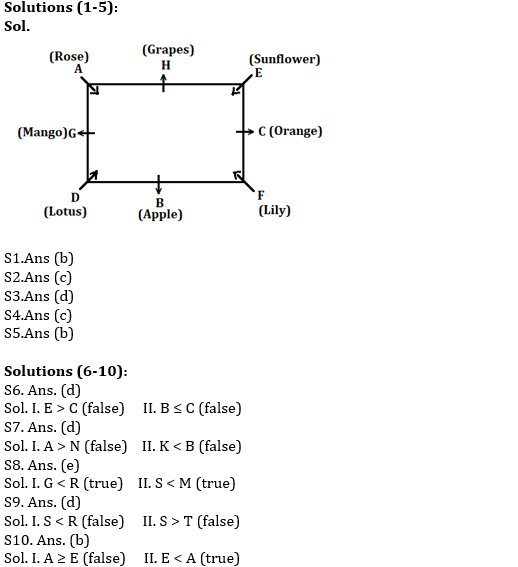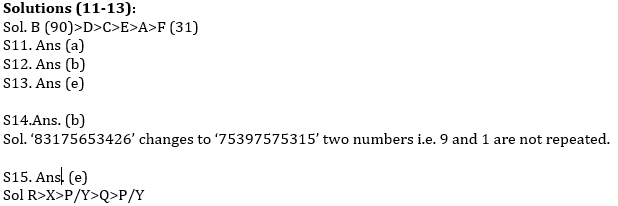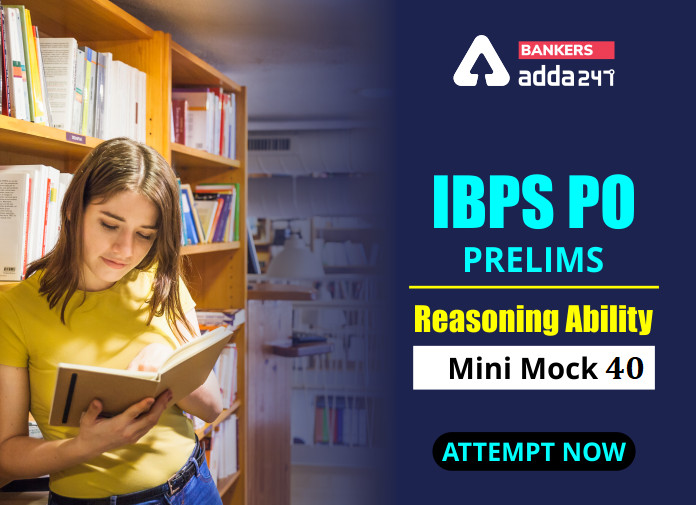Directions (1-5): Study the information carefully and answer the questions given below.
Eight persons i.e. A, B, C, D, E, F, G and H are sitting in square table. Four of them sit at corner face inside and like different flowers i.e. Lotus, Lily, Sunflower and Rose and remaining four persons sit at middle side of square table face outside the center and like different fruits i.e. Mango, Grapes, Orange and Apple. All information is not necessarily in the same order.
Two persons sit between C and the one who likes lotus. The person who likes grapes sit third to the left of the person who likes lotus. One person sits between the one who likes lily and the one who likes sunflower. Three persons sit between A and F. D and B are immediate neighbor to each other. One person sits between C and the one who likes apple. G likes mango. E sits third to the right of G. B likes apple. C does not like grapes. The person who likes lily and the one who likes grapes are not immediate neighbor to each other. A sits second to the left of D.
Q1. Who among the following person sit immediate right of B?
(a) F
(b) D
(c) G
(d) A
(e) None of these
Q2. Who among the following person likes Rose?
(a) F
(b) E
(c) A
(d) G
(e) None of these
Q3. How many persons sit between E and G when counted to the left of G?
(a) Two
(b) One
(c) Three
(d) More than Three
(e) None
Q4. Who among the following person sit second to the right of H?
(a) The one who likes Lily
(b) The one who likes Lotus
(c) The one who likes Orange
(d) The one who likes Mango
(e) None of these
Q5. Four of the following five are alike in certain way based from a group, find the one that does not belong to that group?
(a) A
(b) H
(c) D
(d) E
(e) F
Directions (6-10): In these questions, the relationship between different elements is shown in the statements. The statements are followed by two conclusions. Give answer
Q6.

(a) if only conclusion I is true
(b) if only conclusion II is true
(c) if either conclusion I or II is true
(d) if neither conclusion I nor II is true
(e) if both conclusions I and II are true.
Q7.

(a) if only conclusion I is true
(b) if only conclusion II is true
(c) if either conclusion I or II is true
(d) if neither conclusion I nor II is true
(e) if both conclusions I and II are true.
Q8.

(a) if only conclusion I is true
(b) if only conclusion II is true
(c) if either conclusion I or II is true
(d) if neither conclusion I nor II is true
(e) if both conclusions I and II are true.
Q9.

(a) if only conclusion I is true
(b) if only conclusion II is true
(c) if either conclusion I or II is true
(d) if neither conclusion I nor II is true
(e) if both conclusions I and II are true.
Q10.

(a) if only conclusion I is true
(b) if only conclusion II is true
(c) if either conclusion I or II is true
(d) if neither conclusion I nor II is true
(e) if both conclusions I and II are true.
Directions (11-13): Study the following information carefully and answer the given questions.
Amongst Six friends, A, B, C, D, E and F, each got different marks in the examination. D score marks which is an odd number. D score more marks than E and does not score highest marks. C score more marks than F but less marks than D. C does not score less than E.E score more marks than F and A. A does not score marks that is an odd number. The one who scored the minimum marks scored 31 marks and the one who scored the highest, scored 90 marks.
Q11. Who scored the lowest marks?
(a) F
(b) D
(c) A
(d) B
(e) C
Q12. Who among the following Person has scored third highest marks?
(a) A
(b) C
(c) B
(d) E
(e) Either (a) or (d)
Q13. If C score is 64 then what is possible score of D?
(a) 70
(b) 60
(c) 68
(d) 92
(e) 65
Q14. In the given number ‘83175653426’ if ‘2’ is added to each odd number and ‘1’ is subtracted to each even number then how many digits are not repeated in the resultant thus obtained?
(a) One
(b) Two
(c) Three
(d) Four
(e) None
Q15. Among P, Q, R, X and Y, each one of them is of different age, Q is older than only one person. X is shorter than only R. X is taller than P and Y. Who among them is the third tallest?
(a) P
(b) Q
(c) R
(d) Y
(e) Can’t be determined
Practice More Questions of Reasoning for Competitive Exams:
Solutions


Download PDF of this Reasoning Quiz for IBPS PO 2020
Practice with Crash Course and Online Test Series for IBPS PO Prelims:




 GA Capsule for SBI Clerk Mains 2025, Dow...
GA Capsule for SBI Clerk Mains 2025, Dow...
 The Hindu Review October 2022: Download ...
The Hindu Review October 2022: Download ...
 IB ACIO 2025 Notification PDF Out for 37...
IB ACIO 2025 Notification PDF Out for 37...


